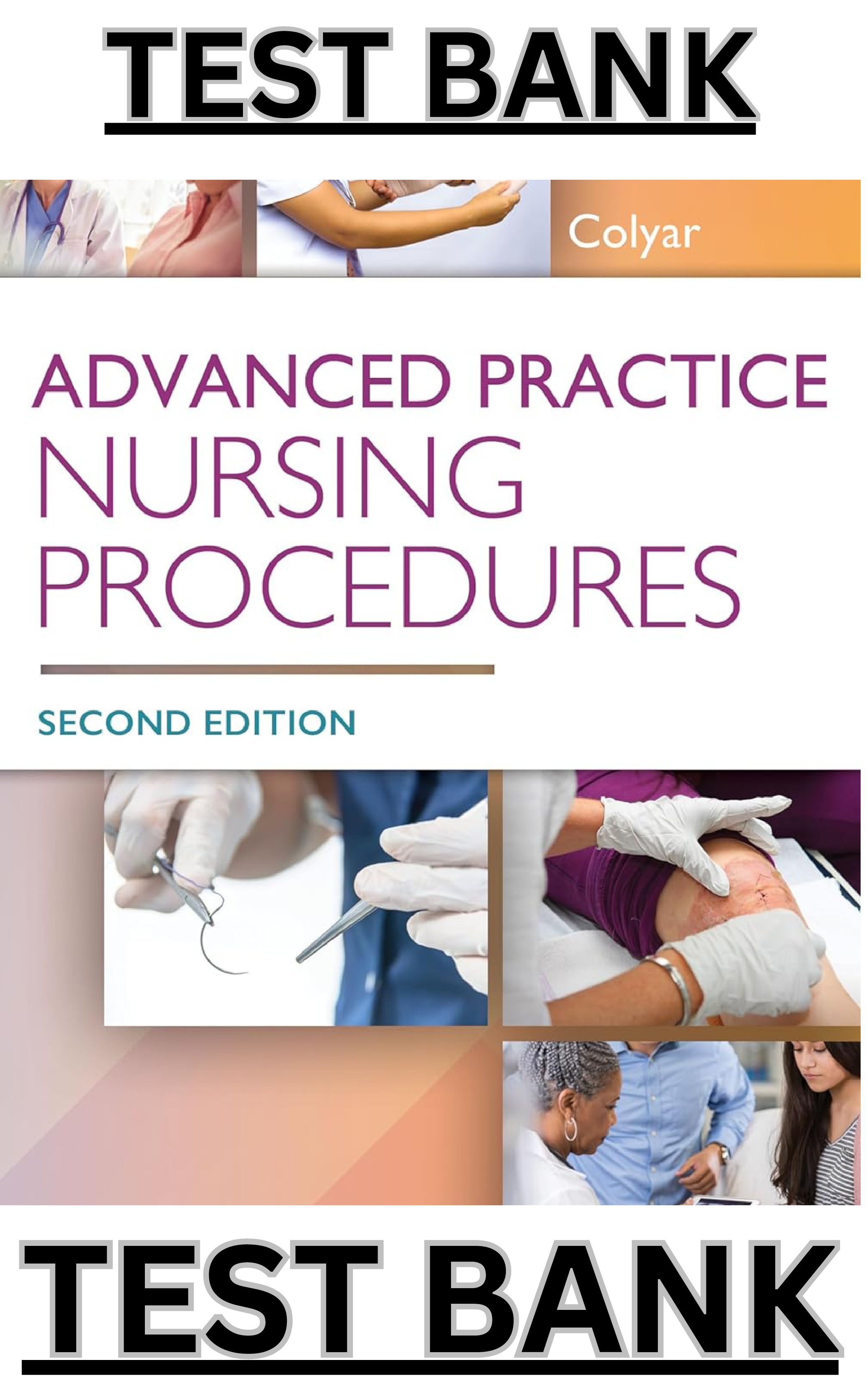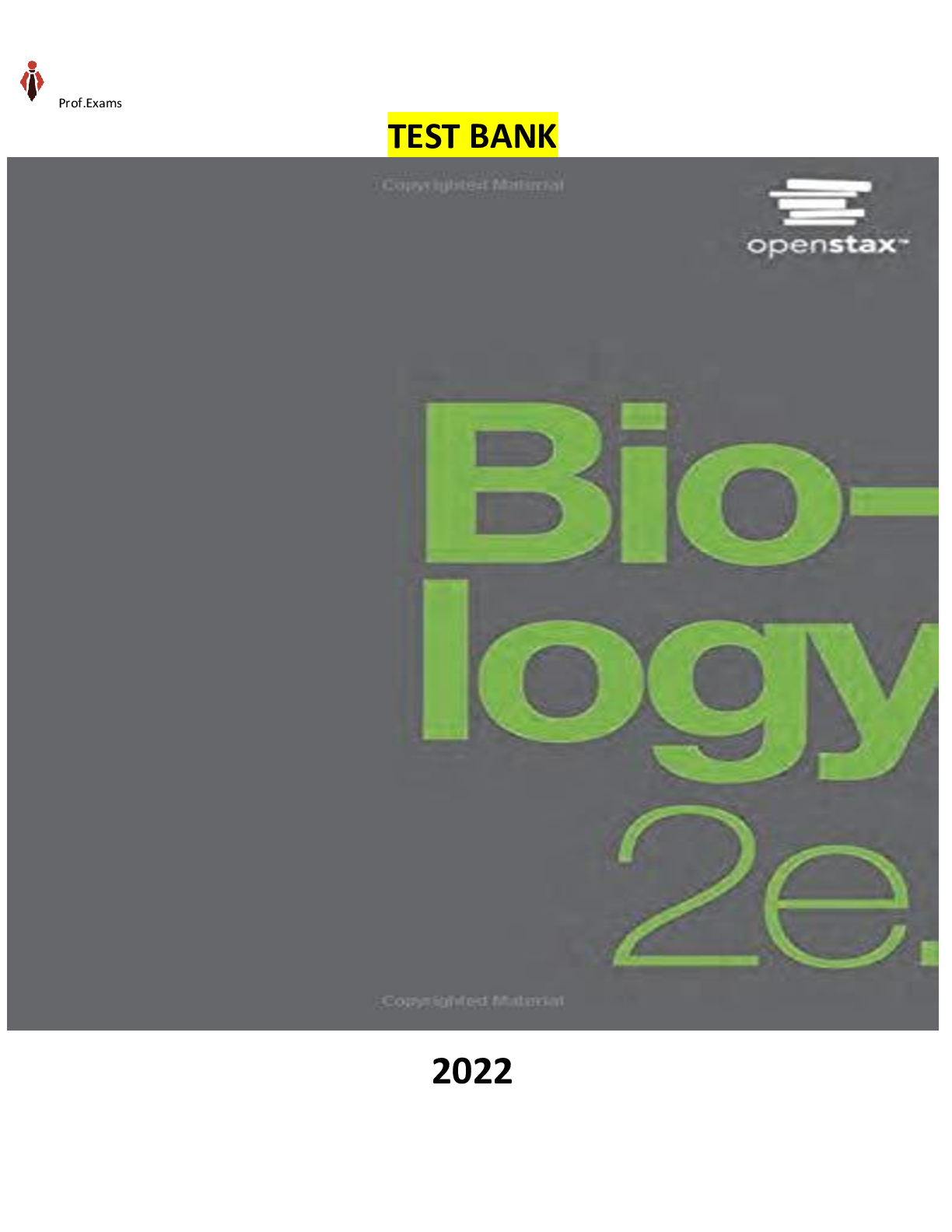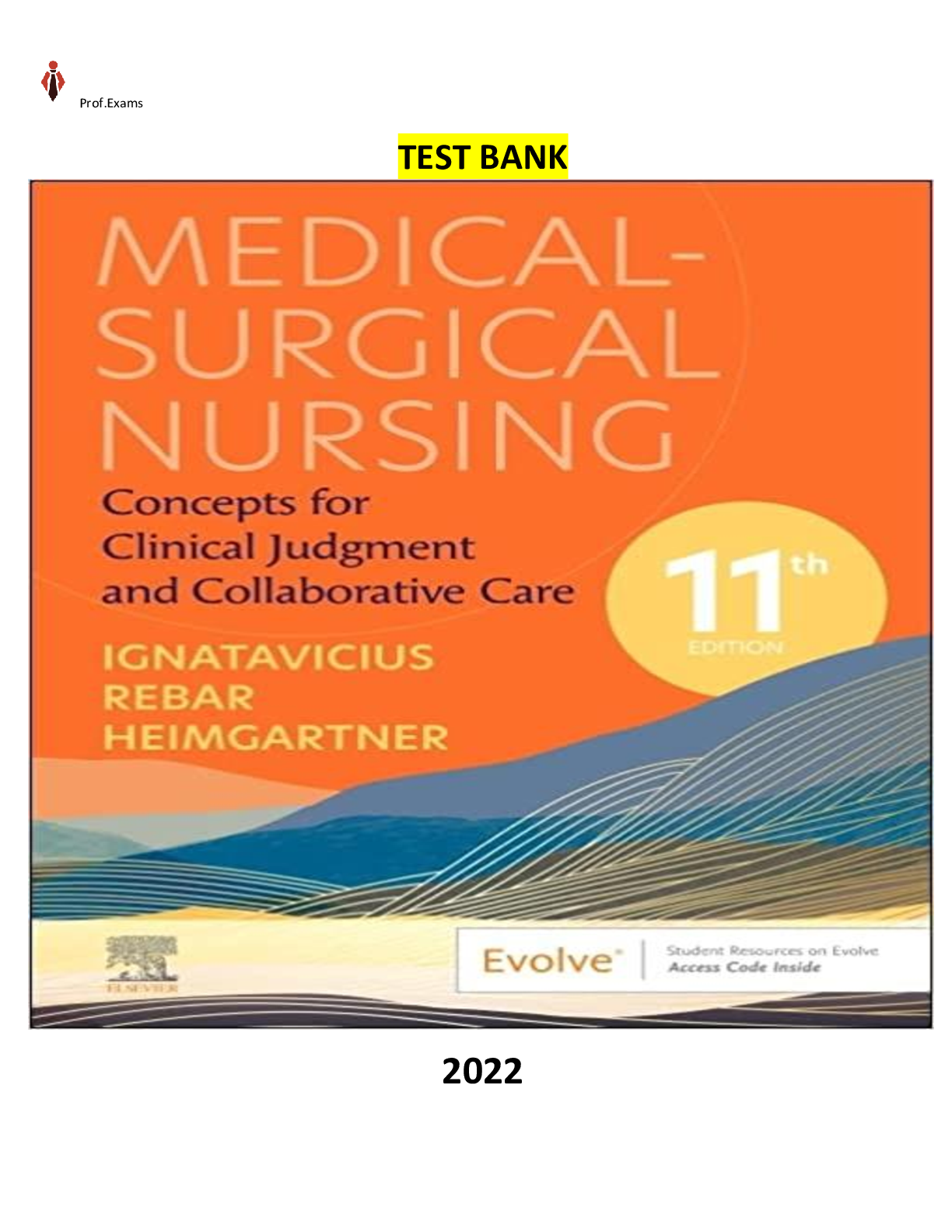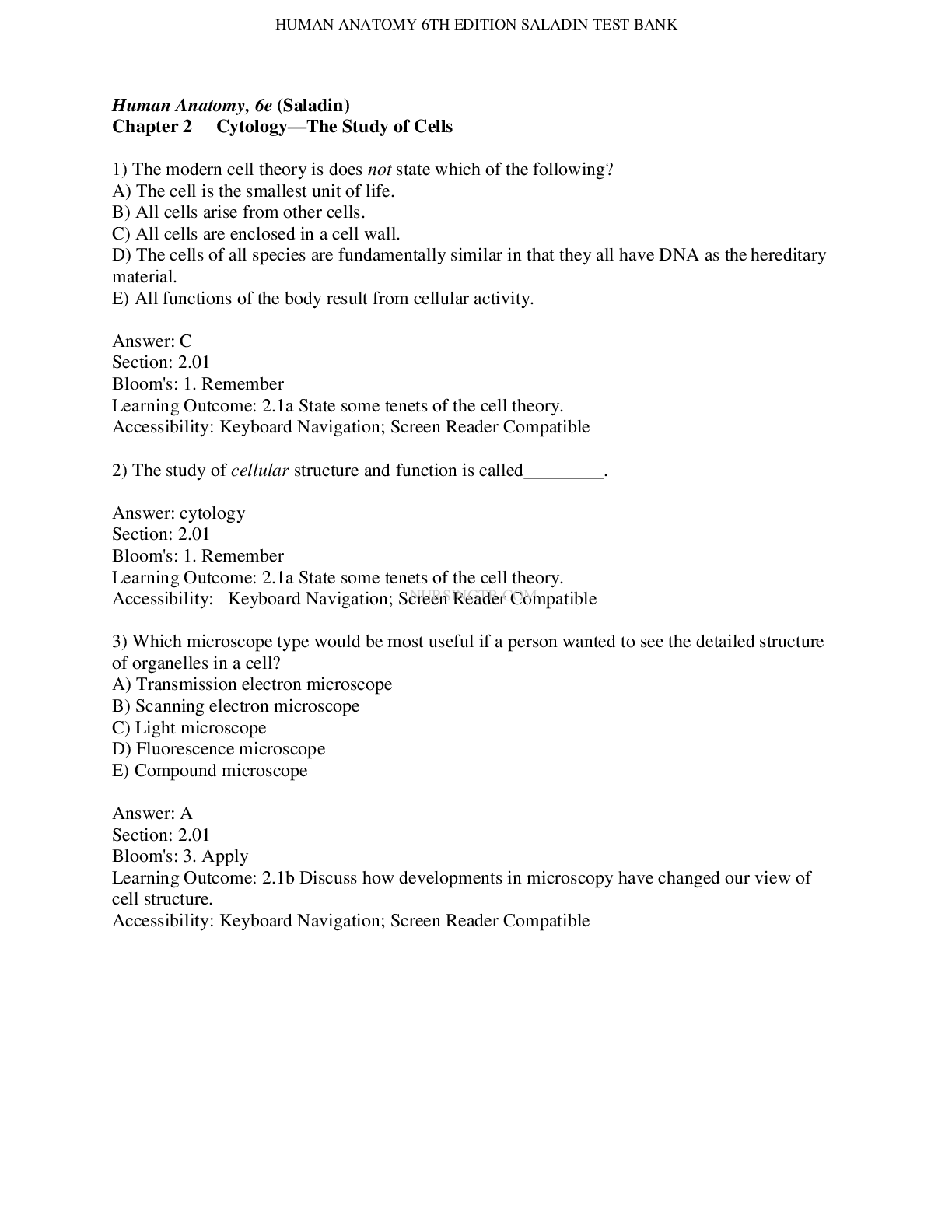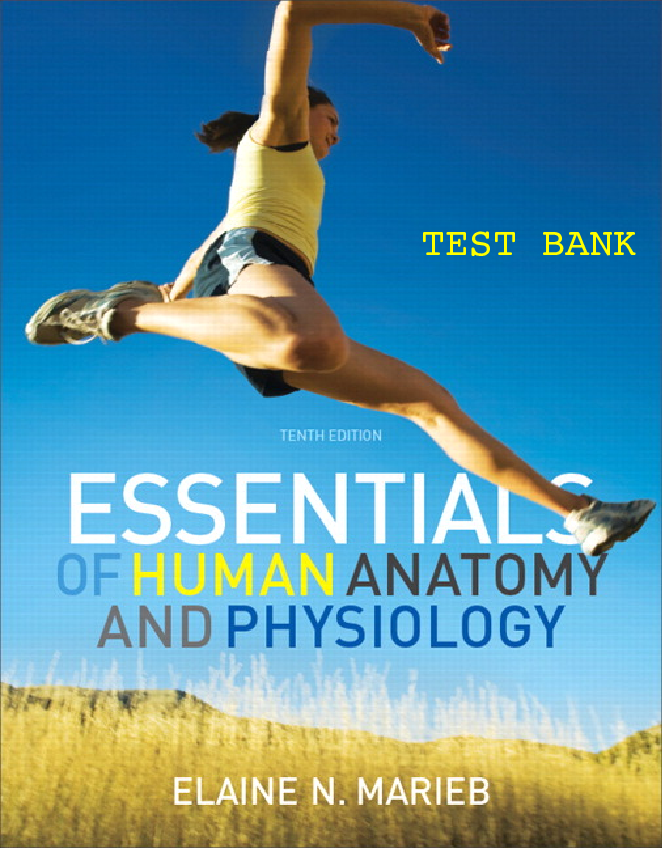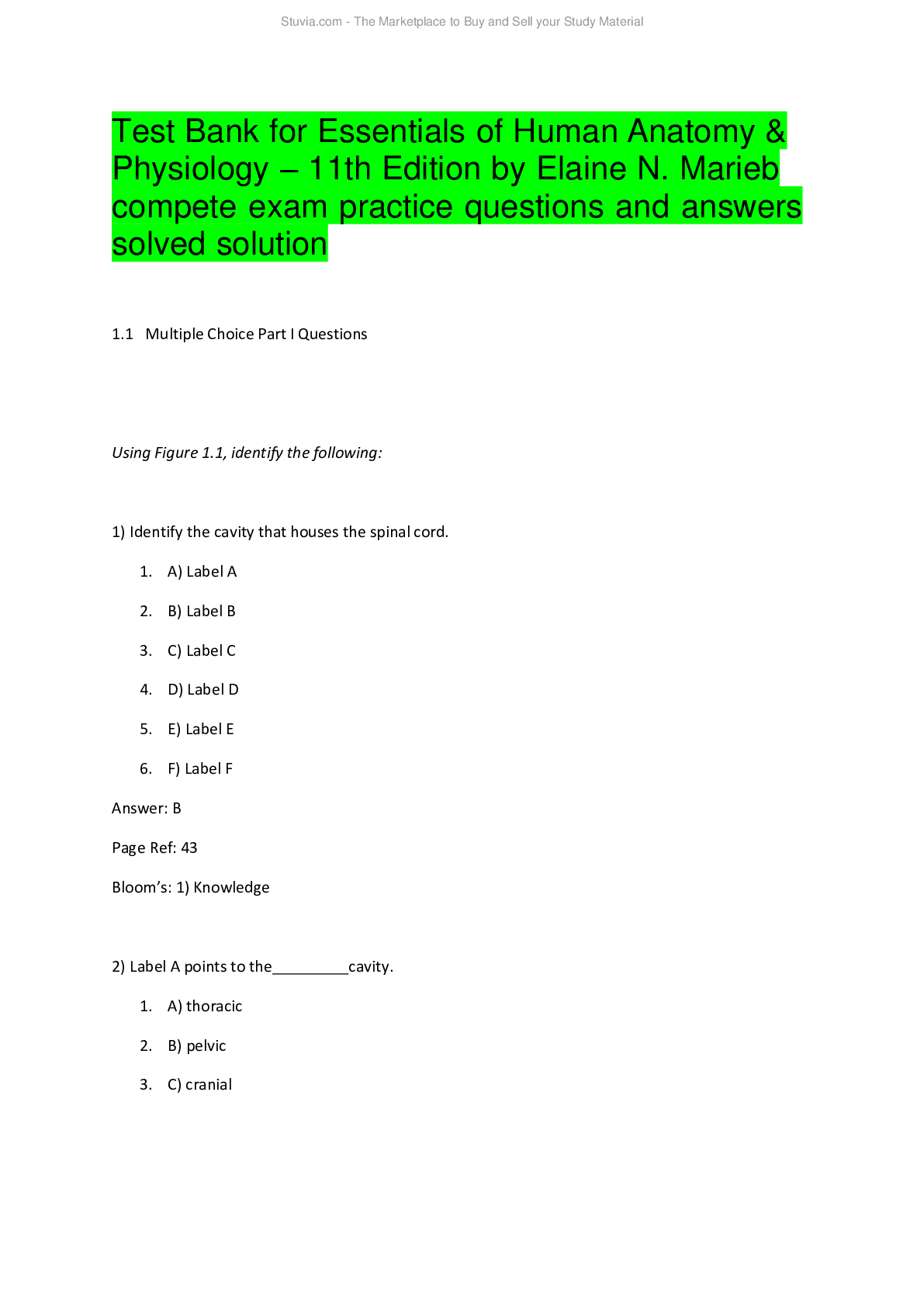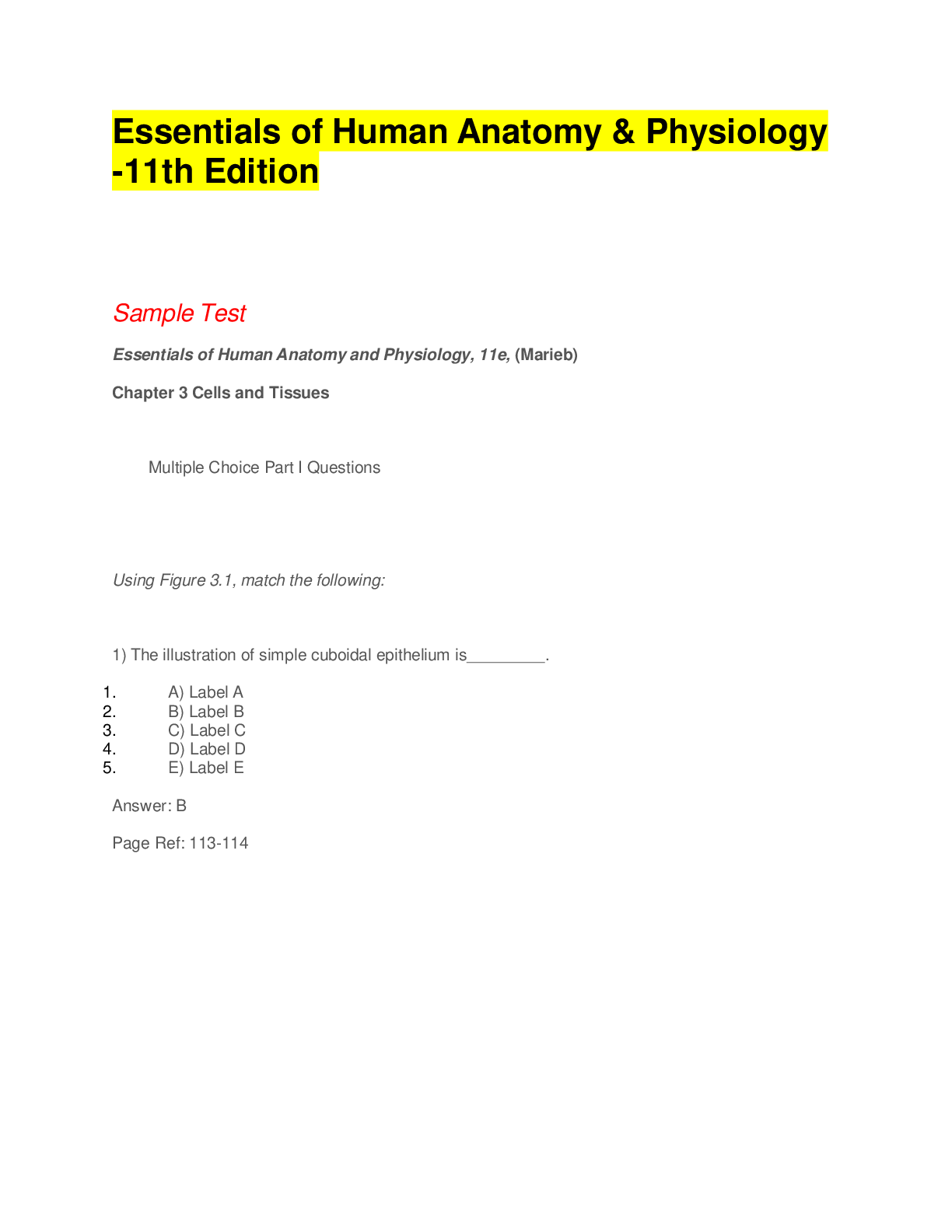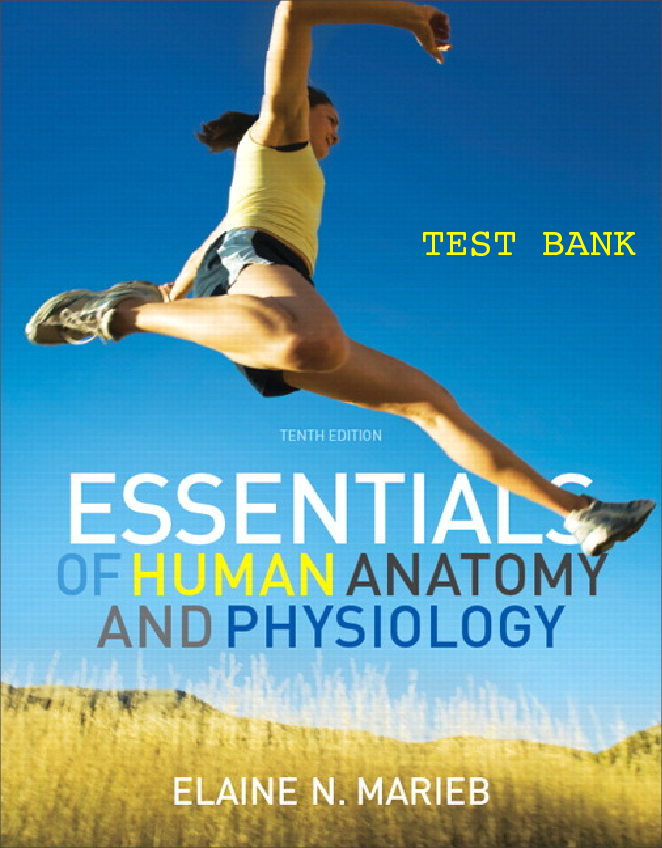*NURSING > TEST BANK > COMPLETE - Elaborated Test bank for Human Anatomy & Physiology 12Ed. by Elaine N. Marieb & Katja Ho (All)
COMPLETE - Elaborated Test bank for Human Anatomy & Physiology 12Ed. by Elaine N. Marieb & Katja Hoehn ALL Chapters1-16 included 675 pages with Questions & Answers-LATEST
Document Content and Description Below
COMPLETE - Elaborated Test bank for Human Anatomy & Physiology 12Ed. by Elaine N. Marieb & Katja Hoehn ALL Chapters1-16 included 675 pages with Questions & Answers-LATEST COMPLETE - Elaborated Test ... bank for Human Anatomy & Physiology 12Ed. by Elaine N. Marieb & Katja Hoehn COMPLETE - Elaborated Test bank for Human Anatomy & Physiology 12Ed. by Elaine N. Marieb & Katja Hoehn ALL Chapters1-16 included 675 pages with Questions & Answers-LATEST TABLE OF CONTENTS 1. The Human Body: An Orientation 2. Basic Chemistry 3. Cells and Tissues 4. Skin and Body Membranes 5. The Skeletal System 6. The Muscular System 7. The Nervous System 8. Special Senses 9. The Endocrine System 10. Blood 11. The Cardiovascular System 12. The Lymphatic System and Body Defenses 13. The Respiratory System 14. The Digestive System and Body Metabolism 15. The Urinary System 16. The Reproductive System Detailed Topics: An Overview of Anatomy and Physiology Anatomy Physiology Relationship between Anatomy and Physiology Levels of Structural Organization From Atoms to Organisms Organ System Overview Integumentary System Skeletal System Muscular System Nervous System Endocrine System Cardiovascular System Lymphatic System Respiratory System Digestive System Urinary System Reproductive System Maintaining Life Necessary Life Functions Maintaining Boundaries Movement Responsiveness Digestion Metabolism Excretion Reproduction Growth Survival Needs The Language of Anatomy Anatomical Position Directional Terms Regional Terms Anterior Body Landmarks Posterior Body Landmarks Body Planes and Sections Body Cavities Dorsal Body Cavity Ventral Body Cavity Other Body Cavities Homeostasis Components of Homeostatic Control Systems Feedback Mechanisms Summary 2 Basic Chemistry Concepts of Matter and Energy Matter Energy Forms of Energy Energy Form Conversions Composition of Matter Elements and Atoms Atomic Structure The Basic Atomic Subparticles Planetary and Orbital Models of an Atom Identifying Elements Atomic Number Atomic Mass Number Atomic Weight and Isotopes Molecules and Compounds Chemical Bonds and Chemical Reactions Bond Formation Role of Electrons Types of Chemical Bonds Ionic Bonds Covalent Bonds Hydrogen Bonds Patterns of Chemical Reactions Synthesis Reactions Decomposition Reactions Exchange Reactions Factors Influencing the Rate of Chemical Reactions Biochemistry: The Chemical Composition of Living Matter Inorganic Compounds Water Salts Acids and Bases Characteristics of Acids Characteristics of Bases Acids, Bases, and Neutralization pH: Acid-Base Concentrations Organic Compounds Carbohydrates Monosaccharides Disaccharides Polysaccharides Lipids Triglycerides Phospholipids. Steroids Proteins Structural Levels of Proteins Fibrous and Globular Proteins Enzymes and Enzyme Activity Nucleic Acids Adenosine Triphosphate (ATP) 3 Cells and Tissues Part I: Cells Overview of the Cellular Basis of Life Anatomy of a Generalized Cell The Nucleus Nuclear Envelope Nucleolus Chromatin The Plasma Membrane The Fluid Mosaic Model Cell Membrane Junctions The Cytoplasm Cytosol and Inclusions Organelles Mitochondria Ribosomes Endoplasmic Reticulum Golgi Apparatus Lysosomes Peroxisomes Cytoskeleton Centrioles Cell Extensions Cilia and Flagella Microvilli Cell Diversity Cell Physiology Membrane Transport Passive Processes: Diffusion and Filtration Diffusion Filtration Active Processes Active Transport Vesicular Transport Cell Division Preparations: DNA Replication Events of Cell Division Mitosis Cytokinesis Protein Synthesis Genes: The Blueprint for Protein Structure The Role of RNA The Process of Protein Synthesis Transcription Translation Part II: Body Tissues Epithelial Tissue Hallmarks of Epithelium Classification of Epithelia Simple Epithelia Simple Squamous Epithelium Simple Cuboidal Epithelium Simple Columnar Epithelium Pseudostratified Columnar Epithelium Stratified Epithelia Stratified Squamous Epithelium Stratified Cuboidal and Stratified Columnar Epithelia Transitional Epithelium Glandular Epithelium Connective Tissue Hallmarks of Connective Tissue Extracellular Matrix Types of Connective Tissue Bone Cartilage Dense Connective Tissue Loose Connective Tissue Areolar Connective Tissue Adipose Connective Tissue Reticular Connective Tissue Blood Muscle Tissue Skeletal Muscle Cardiac Muscle Smooth Muscle Nervous Tissue Tissue Repair (Wound Healing) Part III: Developmental Aspects of Cells and Tissues 4 Skin and Body Membranes Classification of Body Membranes Epithelial Membranes Cutaneous Membrane Mucous Membranes Serous Membranes Connective Tissue Membranes The Integumentary System (Skin) Functions of the Integumentary System Structure of the Skin Epidermis Dermis Skin Color Appendages of the Skin Cutaneous Glands Sebaceous (Oil) Glands Sweat Glands Hair and Hair Follicles Hairs Hair Follicles Nails Homeostatic Imbalances of Skin Infections and Allergies Burns Skin Cancer Basal Cell Carcinoma Squamous Cell Carcinoma Malignant Melanoma Developmental Aspects of Skin and Body Membranes 5 The Skeletal System Bones: An Overview Functions of the Bones Classification of Bones Structure of Bone Gross Anatomy of a Long Bone Microscopic Anatomy Bone Formation, Growth, and Remodeling Bone Formation and Growth Bone Remodeling Bone Fractures Axial Skeleton Skull Cranium Frontal Bone Parietal Bones Temporal Bones Occipital Bone Sphenoid Bone Ethmoid Bone Facial Bones Maxillae Palatine Bones Zygomatic Bones Lacrimal Bones Nasal Bones Vomer Bone Inferior Nasal Conchae Mandible The Hyoid Bone Vertebral Column (Spine) Cervical Vertebrae Thoracic Vertebrae Lumbar Vertebrae Sacrum Coccyx Thoracic Cage Sternum Ribs Appendicular Skeleton Bones of the Shoulder Girdle Bones of the Upper Limbs Arm Forearm Hand Bones of the Pelvic Girdle Bones of the Lower Limbs Thigh Leg Foot Joints Fibrous Joints Cartilaginous Joints Synovial Joints Types of Synovial Joints Based on Shape Developmental Aspects of the Skeleton Birth to Adulthood Older Adults 6 The Muscular System Overview of Muscle Tissues Muscle Types Skeletal Muscle Smooth Muscle Cardiac Muscle Muscle Functions Produce Movement Maintain Posture and Body Position Stabilize Joints Generate Heat Additional Functions Microscopic Anatomy of Skeletal Muscle Skeletal Muscle Activity Stimulation and Contraction of Single Skeletal Muscle Fibers The Nerve Stimulus and the Action Potential Mechanism of Muscle Contraction: The Sliding Filament Theory Contraction of a Skeletal Muscle as a Whole Graded Responses Muscle Response to Increasingly Rapid Stimulation Muscle Response to Stronger Stimuli Providing Energy for Muscle Contraction Muscle Fatigue and Oxygen Deficit Types of Muscle Contractions—Isotonic and Isometric Muscle Tone Effect of Exercise on Muscles Muscle Movements, Roles, and Names Types of Body Movements Special Movements Interactions of Skeletal Muscles in the Body Naming Skeletal Muscles Arrangement of Fascicles Gross Anatomy of Skeletal Muscles Head and Neck Muscles Facial Muscles Frontalis Orbicularis Oculi Orbicularis Oris Buccinator Zygomaticus Masseter Temporalis Neck Muscles Platysma Sternocleidomastoid Trunk Muscles Anterior Muscles Pectoralis Major Intercostal Muscles Muscles of the Abdominal Girdle Posterior Muscles Trapezius Latissimus Dorsi Erector Spinae Quadratus Lumborum Deltoid Muscles of the Upper Limb Muscles Causing Movement at the Elbow Joint Biceps Brachii Brachialis Brachioradialis Triceps Brachii Muscles of the Lower Limb Muscles Causing Movement at the Hip Joint Gluteus Maximus Gluteus Medius Iliopsoas Adductor Muscles Muscles Causing Movement at the Knee Joint (Figure 6.20) Hamstring Group Sartorius Quadriceps Group Muscles Causing Movement at the Ankle and Foot (Figure 6.21) Tibialis Anterior Extensor Digitorum Longus Fibularis Muscles Gastrocnemius Soleus Developmental Aspects of the Muscular System 7 The Nervous System Organization of the Nervous System Structural Classification Functional Classification Nervous Tissue: Structure and Function Supporting Cells Neurons Anatomy Cell Body Processes Myelin Sheaths Terminology Classification Functional Classification Structural Classification Physiology: Nerve Impulses Electrical Conditions of a Resting Neuron’s Membrane Action Potential Initiation and Generation Transmission of the Signal at Synapses Physiology: Reflexes Central Nervous System Functional Anatomy of the Brain Cerebral Hemispheres Cerebral Cortex Cerebral White Matter Basal Nuclei Diencephalon Brain Stem Midbrain Pons Medulla Oblongata Reticular Formation Cerebellum Protection of the Central Nervous System Meninges Cerebrospinal Fluid The Blood-Brain Barrier Brain Dysfunctions Spinal Cord Gray Matter of the Spinal Cord and Spinal Roots White Matter of the Spinal Cord Peripheral Nervous System Structure of a Nerve Cranial Nerves Spinal Nerves and Nerve Plexuses Autonomic Nervous System Somatic and Autonomic Nervous Systems Compared Anatomy of the Parasympathetic Division Anatomy of the Sympathetic Division Autonomic Functioning Sympathetic Division Parasympathetic Division Developmental Aspects of the Nervous System 8 Special Senses Part I: The Eye and Vision Anatomy of the Eye External and Accessory Structures Internal Structures: The Eyeball Layers Forming the Wall of the Eyeball Fibrous Layer Vascular Layer Sensory Layer Lens Physiology of Vision Pathway of Light through the Eye and Light Refraction Visual Fields and Visual Pathways to the Brain Eye Reflexes Part II: The Ear: Hearing and Balance Anatomy of the Ear External (Outer) Ear Middle Ear Internal (Inner) Ear Equilibrium Static Equilibrium Dynamic Equilibrium Hearing Hearing and Equilibrium Deficits Part III: Chemical Senses: Smell and Taste Olfactory Receptors and the Sense of Smell Taste Buds and the Sense of Taste Part IV: Developmental Aspects of the Special Senses 9 The Endocrine System The Endocrine System and Hormone Function—An Overview The Chemistry of Hormones Hormone Action Direct Gene Activation Second-Messenger System Stimuli for Control of Hormone Release Hormonal Stimuli Humoral Stimuli Neural Stimuli The Major Endocrine Organs Pituitary Gland and Hypothalamus Pituitary-Hypothalamus Relationships Posterior Pituitary and Hypothalamic Hormones Anterior Pituitary Hormones Pineal Gland Thyroid Gland Parathyroid Glands Thymus Adrenal Glands Hormones of the Adrenal Cortex Hormones of the Adrenal Medulla Pancreatic Islets Gonads Hormones of the Ovaries Hormones of the Testes Other Hormone-Producing Tissues and Organs Developmental Aspects of the Endocrine System 10 Blood Composition and Functions of Blood Components Physical Characteristics and Volume Plasma Formed Elements Erythrocytes Leukocytes Platelets Hematopoiesis (Blood Cell Formation) Formation of Red Blood Cells Formation of White Blood Cells and Platelets Hemostasis Phases of Hemostasis Disorders of Hemostasis Blood Groups and Transfusions Human Blood Groups Blood Typing Developmental Aspects Of Blood 11 The Cardiovascular System The Heart Anatomy of the Heart Size, Location, and Orientation Coverings and Walls of the Heart Chambers and Associated Great Vessels Heart Valves Cardiac Circulation Physiology of the Heart Intrinsic Conduction System of the Heart: Setting the Basic Rhythm Cardiac Cycle and Heart Sounds Cardiac Output Regulation of Stroke Volume Factors Modifying Basic Heart Rate Blood Vessels Microscopic Anatomy of Blood Vessels Tunics Structural Differences in Arteries, Veins, and Capillaries Gross Anatomy of Blood Vessels Major Arteries of the Systemic Circulation Major Veins of the Systemic Circulation Veins Draining into the Superior Vena Cava Veins Draining into the Inferior Vena Cava Special Circulations Arterial Supply of the Brain and the Circle of Willis Hepatic Portal Circulation Physiology of Circulation Arterial Pulse Blood Pressure Blood Pressure Gradient Measuring Blood Pressure Effects of Various Factors on Blood Pressure Variations in Blood Pressure Capillary Exchange of Gases and Nutrients Fluid Movements at Capillary Beds Developmental Aspects of the Cardiovascular System 12 The Lymphatic System and Body Defenses Part I: The Lymphatic System Lymphatic Vessels Lymph Nodes Other Lymphoid Organs Part II: Body Defenses Innate Body Defenses Surface Membrane Barriers Internal Defenses: Cells and Chemicals Natural Killer Cells Inflammatory Response Phagocytes Antimicrobial Proteins Complement Interferon Fever Adaptive Body Defenses Antigens Cells of the Adaptive Defense System: An Overview Lymphocytes Antigen-Presenting Cells Humoral (Antibody-Mediated) Immune Response Active and Passive Humoral Immunity Antibodies Basic Antibody Structure Antibody Classes Antibody Function Cellular (Cell-Mediated) Immune Response Organ Transplants and Rejection Disorders of Immunity Part III: Developmental Aspects of the Lymphatic System and Body Defenses 13 The Respiratory System Functional Anatomy of the Respiratory System The Nose The Pharynx The Larynx The Trachea The Main Bronchi The Lungs The Bronchial Tree Respiratory Zone Structures and the Respiratory Membrane Respiratory Physiology Mechanics of Breathing Inspiration Expiration Respiratory Volumes and Capacities Nonrespiratory Air Movements Respiratory Sounds External Respiration, Gas Transport, and Internal Respiration External Respiration Gas Transport in the Blood Internal Respiration Control of Respiration Neural Regulation: Setting the Basic Rhythm Nonneural Factors Influencing Respiratory Rate and Depth Physical Factors Volition (Conscious Control) Emotional Factors Chemical Factors Respiratory Disorders Developmental Aspects of the Respiratory System 14 The Digestive System and Body Metabolism Part I: Anatomy and Physiology of the Digestive System Anatomy of the Digestive System Organs of the Alimentary Canal Mouth Pharynx Esophagus Stomach Small Intestine Large Intestine Accessory Digestive Organs Teeth Salivary Glands Pancreas Liver and Gallbladder Functions of the Digestive System Overview of Gastrointestinal Processes and Controls Activities Occurring in the Mouth, Pharynx, and Esophagus Food Ingestion and Breakdown Food Propulsion—Swallowing and Peristalsis Activities of the Stomach Food Breakdown Food Propulsion Activities of the Small Intestine Chyme Breakdown and Absorption Chyme Propulsion Activities of the Large Intestine Nutrient Breakdown and Absorption Propulsion of Food Residue and Defecation Part II: Nutrition and Metabolism Nutrition Dietary Recommendations Dietary Sources of the Major Nutrients Carbohydrates Lipids Proteins Vitamins Minerals Metabolism Carbohydrate, Fat, and Protein Metabolism in Body Cells Carbohydrate Metabolism Fat Metabolism Protein Metabolism The Central Role of the Liver in Metabolism General Metabolic Functions Cholesterol Metabolism and Transport Body Energy Balance Regulation of Food Intake Metabolic Rate and Body Heat Production Basal Metabolic Rate Total Metabolic Rate Body Temperature Regulation Heat-Promoting Mechanisms Heat Loss Mechanisms Part III: Developmental Aspects of the Digestive System and Metabolism 15 The Urinary System Kidneys Location and Structure Kidney Structure Blood Supply Nephrons Urine Formation and Characteristics Glomerular Filtration Tubular Reabsorption Tubular Secretion Nitrogenous Wastes Characteristics of Urine Ureters, Urinary Bladder, and Urethra Ureters Urinary Bladder Urethra Micturition Fluid, Electrolyte, and Acid-Base Balance Maintaining Water Balance of Blood Body Fluids and Fluid Compartments The Link between Water and Electrolytes Regulation of Water Intake and Output Maintaining Electrolyte Balance Maintaining Acid-Base Balance of Blood Blood Buffers Respiratory Mechanisms Renal Mechanisms Developmental Aspects of the Urinary System 16 The Reproductive System Anatomy of the Male Reproductive System Testes Duct System Epididymis Ductus Deferens Urethra Accessory Glands and Semen Seminal Vesicles Prostate Bulbourethral Glands Semen External Genitalia Male Reproductive Functions Spermatogenesis Testosterone Production Anatomy of the Female Reproductive System Ovaries Duct System Uterine Tubes Uterus Vagina External Genitalia and Female Perineum Female Reproductive Functions and Cycles Oogenesis and the Ovarian Cycle Hormone Production by the Ovaries Uterine (Menstrual) Cycle Mammary Glands Pregnancy and Embryonic Development Accomplishing Fertilization Events of Embryonic and Fetal Development Effects of Pregnancy on the Mother Anatomical Changes Physiological Changes Gastrointestinal System Urinary System Respiratory System Cardiovascular System Childbirth Initiation of Labor Stages of Labor Stage 1: Dilation Stage Stage 2: Expulsion Stage Stage 3: Placental Stage Developmental Aspects of the Reproductive System. [Show More]
Last updated: 1 year ago
Preview 1 out of 678 pages
Instant download
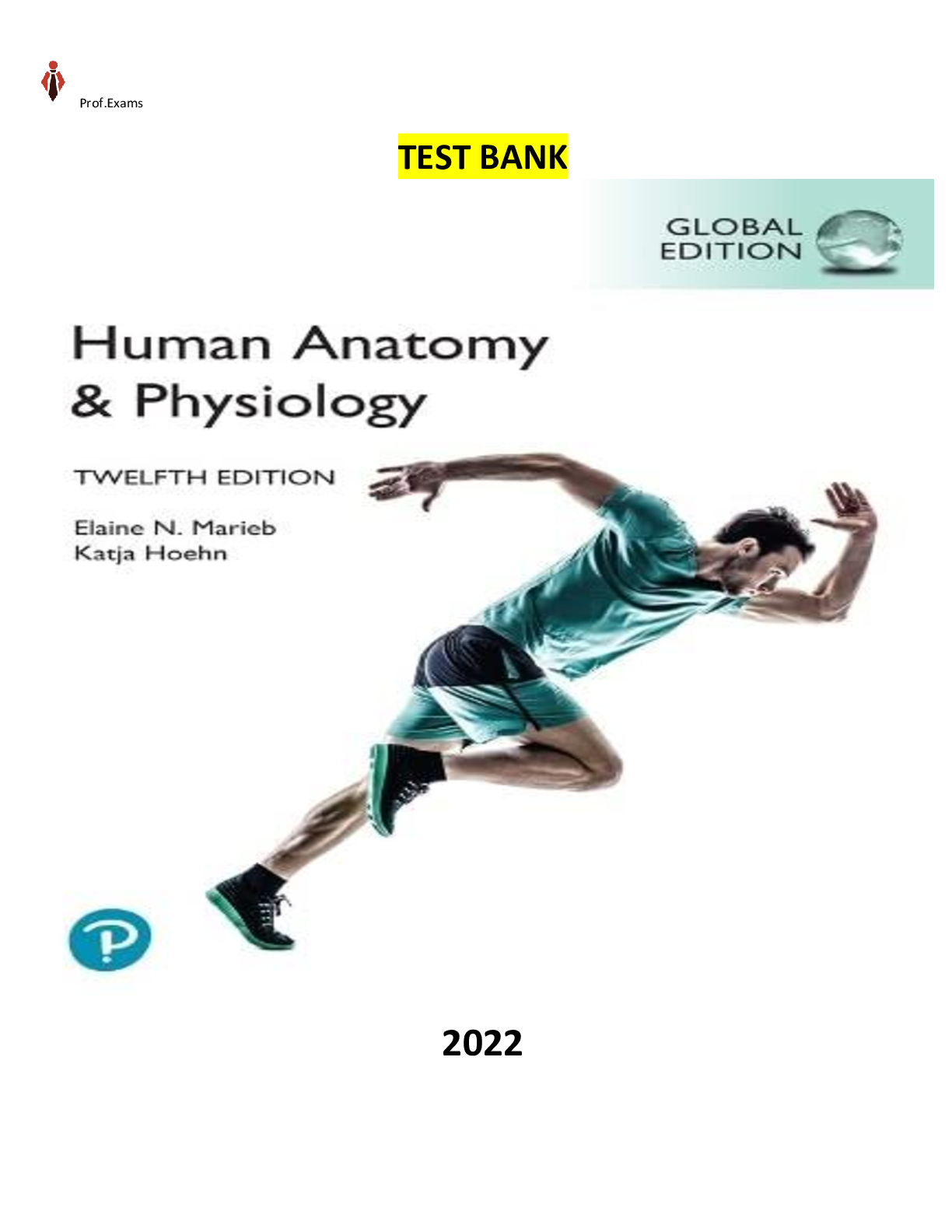
Buy this document to get the full access instantly
Instant Download Access after purchase
Add to cartInstant download
Reviews( 0 )
Document information
Connected school, study & course
About the document
Uploaded On
Apr 01, 2023
Number of pages
678
Written in
Additional information
This document has been written for:
Uploaded
Apr 01, 2023
Downloads
0
Views
49

